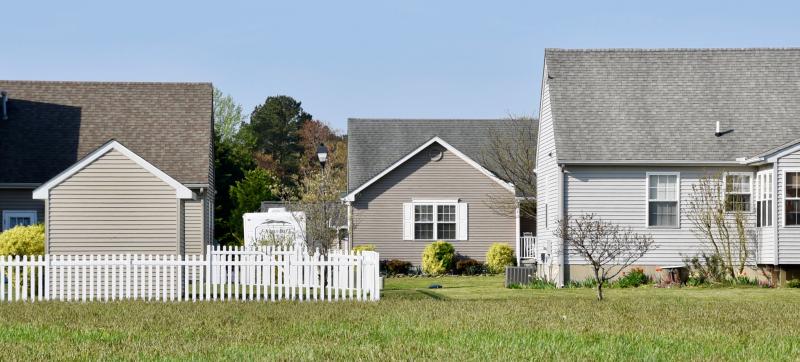Sussex County has established setback regulations, but when a building goes up, there is no setback inspection until construction is completed. As a result, buildings can be built and pole barns and sheds can be placed on properties in violation of setback requirements.
A property owner is then forced to file a $400 variance application and appear at a public hearing before the Sussex County Board of Adjustment.
County officials are now looking at doing those inspections before construction begins.
“It's a legacy issue we want to address,” said Sussex County Administrator Todd Lawson during the April 9 Sussex County Council meeting. “You can think of the problems that could occur.”
And they do.
Recently the board of adjustment granted a Paradise Road Georgetown resident an 11-foot rear-yard setback for a pole building. According to county code, the setback was supposed to be 20 feet, yet the building's rear setback was only half that distance.
Michael Mears, the applicant, told the board that the builder had plenty of room to build the pole shed without going into the setback. “The placement is not our fault. We never found out about it until the building was put up,” Mears told the board.
It's not an unusual occurrence at the board of adjustment. The board eventually granted a variance, but Lawson said board members asked county staff to review the process.
Lawson said it makes sense to inspect before construction and expenses have occurred. “We'd like to have our eyes on this before it happens,” he said.
Recommendations to improve process
Lawson offered recommendations to county council to adjust the county's permitting and inspection processes.
• County staff will inspect at the beginning of the process for setback and right-of-way compliance.
• If an inspection fails, construction would be stopped.
• If a setback or right-of-way measurement is too close or inconclusive, a survey or an as-built drawing may be required before construction can continue.
• Explain setbacks and tax ditch right-of-way restrictions to every applicant.
• Develop a new permit application form that each applicant must sign verifying their understanding of the process for setback and right-of-way compliance.
• Coordinate daily with the Delaware Department of Natural Resources and Environmental Control when an applicant applies for a permit on a tax ditch.
Cracking down on violators
Under the current process, county staff reviews information for a building permit including property zoning, size and dimensions of a structure and any restrictions on the property such as tax-ditch rights of way.
When a permit is issued, the applicant must sign the permit and also initialize the setback section of the building permit. The permit is approved and construction can begin. If a property is located along a tax ditch, a copy of the permit is sent to DNREC.
Lawson said several issues have surfaced. He said many times the person obtaining a building permit is not the builder. In addition, it can be left to a property owner to tell a builder where to place a structure. Also, Lawson said, surveys and site plans are not required with applications, property lines are not always easily identified and tax-ditch rights of way are usually unknown to property owners.
Lawson said the same problems do not occur in newer subdivisions because as-built drawing are required to verify housing placements. Before implementing any changes, Lawson said, more training would be required for staff and computer upgrades would be needed.
Lawson said nearly 90 percent of permit applicants follow regulations. “It's the 10 percent not aware or not following the setbacks. That's what we want to catch in the beginning. I'm sure you don't want to get into the business of seeing structures moved or taken down,” Lawson told council.
Lawson said it's not inconceivable that stricter enforcement would be possible if offenders continue to ignore setback regulations. Violators could be responsible for submitting surveys and site plans, which could cost thousands of dollars.
Lawson said if a builder or property owner is not in compliance, they will not be able to move forward with a project. “If they do it anyway, we can issue a violation and even a court injunction. If a person proceeds with full knowledge, it's buyer beware. That's why we want to see the stakes in the ground first,” he said. “We want to use a common sense and easy approach, but we may have to put in other steps if people take advantage of the county's good will.”
Tax-ditch encroachments
Encroachment into tax ditch rights of way is a continuing problem. Tax ditches fall under the jurisdiction of DNREC.
During his presentation, Lawson showed photos of garages, sheds, fences and even a house built within the right of way. There are more than 1,200 miles in the county's 137 tax-ditch-system, draining 232,000 acres, or 38 percent of the county's land.
Tax-ditch rights of way, which can vary by tax district, are created to allow room for ditch maintenance and spoilage placement. Structures cannot be built in the right of way.
Lawson said building permit applicants are made aware of the rights of way when they file for a permit, and they must sign off verifying the rights of way.
Lawson said the county would like to institute a policy to forward permits with tax ditches to DNREC on a daily basis, and not weekly as is currently done.
In addition, he said, DNREC does not have staff to inspect tax ditches, but the county could do site inspections.
What is a tax ditch?
Tax ditches were created by state law in 1951 to assist with drainage issues, primarily for farmland. Residents who live along a tax ditch are part of an organization and pay a tax used to maintain the ditch. The right of way is recorded on property deeds.
In the state: 234 organizations; 2,022 miles; 378,000 acres or 30 percent of land in Delaware; 47,225 properties involved; $854,836 tax ditch tax collected in 2018.






















































